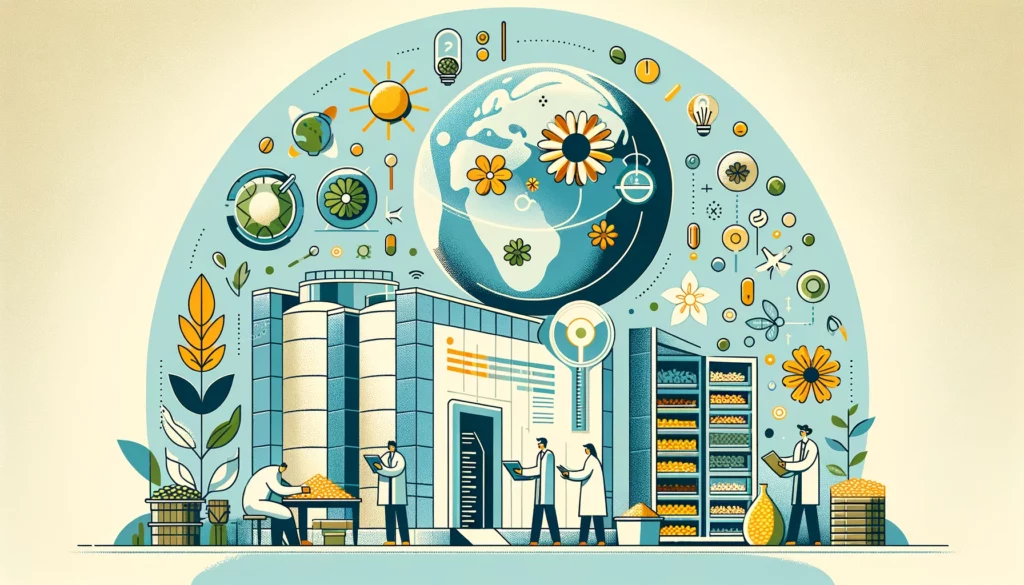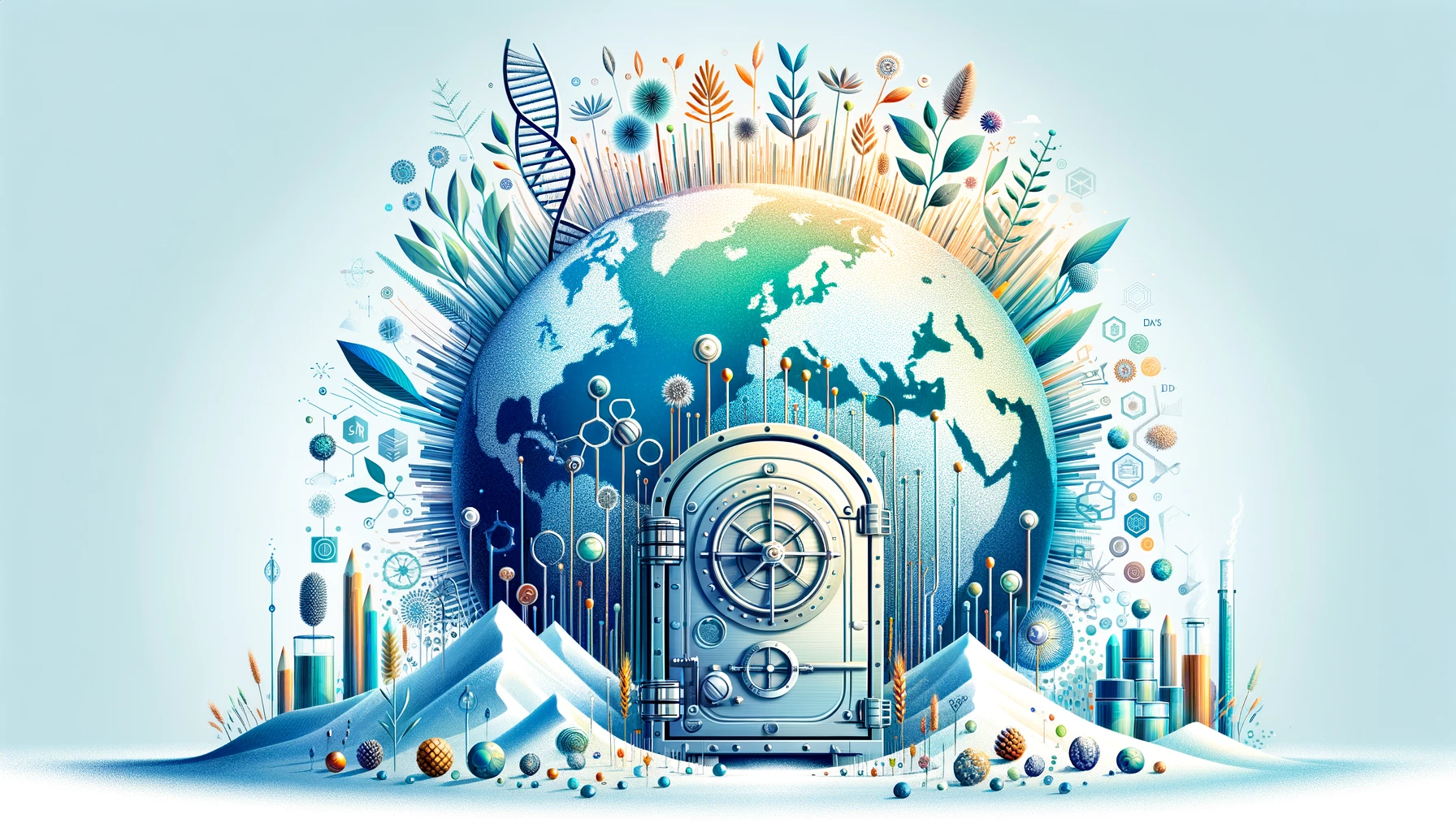In the heart of the Arctic, buried deep within a mountain on a remote island in Norway, lies a modern marvel of biodiversity preservation—the Svalbard Global Seed Vault. Often dubbed the “Doomsday Vault,” it stands as a testament to humanity’s commitment to safeguarding the future of our planet’s flora. Similar initiatives around the globe, including the Baekdudaegan Seed Vault in South Korea, echo this commitment, functioning as vital archives of life capable of enduring the challenges of climate change, war, and natural disasters.
Why Seed Vaults Are Essential
Seed vaults are more than just repositories; they are the ultimate insurance policy for the world’s food supply and ecological diversity. By preserving the genetic diversity of plant species, these vaults play a crucial role in ensuring that, no matter what calamities may befall the Earth, we will have the resources necessary to rebuild and restore ecosystems and agriculture.
Preserving Genetic Diversity
Every seed stored within these vaults carries the genetic blueprint of a plant species, many of which are endemic, rare, or even on the brink of extinction. The Svalbard Vault alone houses over a million seed samples from almost every country in the world. This genetic diversity is crucial for breeding programs, enabling scientists to develop crops that can withstand changing climates, diseases, and pests.
Supporting Agricultural Sustainability
Amidst the backdrop of climate change and a rapidly growing global population, seed vaults stand as pillars of hope. They ensure the availability of a wide array of crop varieties, including traditional and heirloom species that carry traits vital for food security, such as drought resistance or nutritional value.
Conservation of Endangered Species
Seed vaults also serve as a lifeline for endangered plant species, offering a chance for their reintroduction and the restoration of habitats that have been lost to deforestation, urbanization, or natural disasters.
Challenges and Future Directions
Despite their critical importance, seed vaults are not without challenges. The very threats they are designed to protect against—climate change, war, and biodiversity loss—also pose significant risks to their integrity and effectiveness. Moreover, the reliance on these vaults highlights a reactive approach to environmental conservation, emphasizing the need for comprehensive strategies that address the root causes of biodiversity loss.

The Process of Preservation: Inside the Seed Vaults
At the core of biodiversity preservation, seed vaults operate on principles of foresight, diligence, and global cooperation. These sanctuaries of seeds are not merely storage facilities but hubs of scientific endeavor and conservation strategy, ensuring the survival of plant species against the backdrop of ecological and man-made threats.
Collecting the Seeds of Tomorrow
The journey of a seed to a vault is marked by meticulous planning and collaboration. Scientists, conservationists, and local communities worldwide engage in the careful collection of seeds from diverse ecosystems. This global effort ensures the representation of plant species from rainforests to tundras, capturing the genetic diversity essential for future restoration and research projects.
Storing Life’s Blueprint
Upon arrival at the vault, seeds undergo rigorous processing to prepare them for long-term storage. This includes cleaning, drying, and testing for viability, ensuring they remain dormant yet viable for decades or even centuries. The seeds are then sealed in moisture-proof containers and stored in the cold, stable environment of the vault, where conditions are meticulously maintained to prevent degradation.
A Global Effort for a Sustainable Future
Seed vaults embody a global commitment to sustainability and resilience. They serve as the ultimate backup for the world’s crop diversity, safeguarding against the loss of genetic material due to disasters, climate change, and the erosion of agricultural diversity. In the face of challenges, these vaults offer hope for recovery and rebirth, providing the seeds necessary to rebuild ecosystems and sustain future generations.
Challenges and Innovations
While seed vaults stand as bastions of preservation, they face challenges ranging from funding and political support to the impacts of climate change itself. Innovations in technology and strategy, including cryopreservation for seeds not suited to conventional storage and the exploration of new locations for vaults, aim to enhance the resilience and capacity of these crucial resources.
The Path Forward
The existence and expansion of global seed vaults are a testament to humanity’s recognition of the importance of plant biodiversity. As we look to the future, the role of seed vaults will only grow in importance, serving as a cornerstone of our global strategy for ecological preservation, food security, and the adaptation to a changing world.
The Global Network of Seed Vaults: A Deep Dive
Seed vaults, often perceived as fortresses of life, serve a pivotal role in our global efforts to conserve biodiversity. Their operations span from the poles of the Earth to its equatorial regions, each vault playing a unique part in the tapestry of conservation efforts.
The Science of Seed Conservation
The process of seed conservation in vaults is meticulous and scientifically driven. Seeds are collected from around the world, representing the vast diversity of Earth’s flora. From the rarest orchid to the most resilient cereal crops, every seed is a beacon of hope for future generations. Upon arrival at a seed vault, each seed sample undergoes a rigorous process of cleaning, drying, and testing to ensure its viability. They are then stored at optimal conditions, often below freezing, to slow down metabolic processes and prolong their lifespan, potentially for centuries.
The Role of Seed Vaults in Global Biodiversity
Seed vaults are not just storage facilities; they are active participants in global biodiversity conservation. They provide a safety net against the loss of plant species in the wild, offering material for research and restoration projects. The Svalbard Global Seed Vault, for instance, acts as a backup for other seed banks, ensuring that even in the face of disaster, the genetic diversity of our crops is not lost. This global network of vaults and banks forms an invaluable resource for adapting to changing climates, fighting plant diseases, and ensuring food security.
Challenges Facing Seed Vaults
Despite their critical importance, seed vaults face numerous challenges. Climate change poses a significant threat, with rising temperatures and extreme weather events risking the integrity of even the most securely stored seeds. Political instability and war can also endanger seed banks, as seen in the loss of Aleppo’s genebank during the Syrian Civil War. Moreover, the task of collecting and preserving the vast diversity of plant life is daunting and resource-intensive, requiring international cooperation and funding.
Looking to the Future
The future of seed vaults and the biodiversity they aim to preserve depends on global commitment to environmental conservation and sustainability. As we face the challenges of the 21st century, the role of seed vaults will only grow in importance. They are a testament to our recognition of the interconnectedness of all life on Earth and our responsibility to protect it.
Innovations in technology and conservation strategies, coupled with increased international collaboration, offer hope for the expansion and enhancement of seed vaults’ capabilities. By supporting these efforts, we ensure that future generations inherit a world rich in biodiversity, with the tools necessary to nourish and sustain it.

Securing Our Future: The Indispensable Role of Seed Vaults
As we stand at the crossroads of environmental uncertainty and global food security challenges, the role of seed vaults in safeguarding the genetic diversity of plant species has never been more crucial. These vaults, acting as arks of life, embody our collective efforts to ensure the resilience of agriculture and ecosystems against the backdrop of climate change, biodiversity loss, and environmental degradation.
A Beacon of Hope
The global network of seed vaults, from the icy realms of Svalbard to the mountains of South Korea, represents a beacon of hope and innovation. It is a testament to what humanity can achieve when united by a common goal: the preservation of life on Earth for future generations. These vaults not only protect the seeds of today but hold the key to the agricultural innovation of tomorrow, providing the genetic materials necessary to adapt our crops to changing climates and to restore ecosystems that have been damaged or lost.
Call to Action
The story of seed vaults is not just one of scientific achievement; it is a call to action. It urges us to support biodiversity conservation efforts, to engage with and support sustainable agricultural practices, and to advocate for policies that protect the environment. By investing in these living libraries, we are investing in the future of our planet.
A Legacy of Resilience
As we look to the future, the legacy of seed vaults will undoubtedly be one of resilience and foresight. They stand as a powerful symbol of our commitment to preserving the natural world and ensuring food security in the face of adversity. By continuing to support and expand these essential repositories, we can pass on a world that is as diverse, bountiful, and resilient as the seeds within these vaults.
The journey of seed vaults is a compelling narrative of human ingenuity and our deep-rooted connection to the natural world. As we move forward, let us remember the vital role these vaults play in preserving the building blocks of life on Earth. Their story is our story, one of hope, collaboration, and a shared vision for a sustainable future.
Thank you for joining us on this exploration of the unsung heroes of biodiversity—the global seed vaults. May their legacy inspire us to continue working towards a world where biodiversity flourishes and sustains us all.
